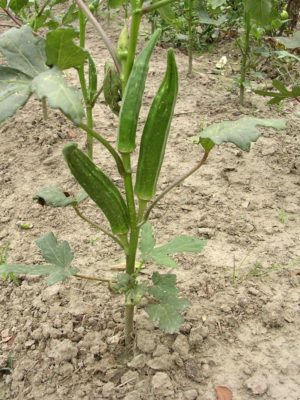
Okra or Lady's finger
Several vegetables and fruits have names that refer to human body parts, such as a “hand of bananas” and a “cabbage head”. Another one is the okra, which is also called “Lady's finger”.
Okra is related to roselle, cotton and jute, which all belong to the Mallow family. It is grown for its green fruits, which are supposed to resemble the fingers of a lady, but any lady with such fingers would probably called a witch.
The origin of okra is in Ethiopia. It can be grown in relatively warm temperate regions.
Okra fruits are eaten as a vegetable. When cooked they are rather slimy.
Names
Scientific
Abelmoschus esculentus
Synonym
Hibiscus esculentus
English
Ladies fingers
Lady fingers
Lady's fingers
Okra
Dutch
Okra
Spanish
Gombo
Ocra
Quimbombo
French
Gombo
Okra
German
Okra
Italian
Abelmosco
Gombo
Taxonomy
Order
Malvales
Family
Malvaceae
Genus
Abelmoschus
Species
Abelmoschus esculentus (Okra)
Basic information and facts
Origin:
Ethiopia
Distribution:
Okra is grown in tropical regions and the relatively warmer temperate regions.
Annual, biennial, or perennial:
Annual or perennial
Flowers:
Okra has big yellow or white flowers that are 4 to 8 centimeter in diameter. The flowers have 5 petals which have a red or purple spot at the base.
Leaves:
The hand-shaped leaves are 10 to 20 centimeters long with 5 to 7 lobes.
Fruits:
The fibrous fruits (or pods) contain round, white seeds. When sliced, the fruits show a pentagonal (having five sides) cross-section. They can reach a length of 18 centimeters.
Climate and weather:
Warm and tropical climates are suitable for okra. It is very heat and drought tolerant.
Pollination:
Okra is pollinated by insects such as bees, wasps, flies and beetles.
Height:
Okra can reach a height of up to 2 meters.
Type of soil:
Lady’s finger can tolerate poor soils.
Moisture:
Seedlings need sufficient water, but when older, okra is a very drought tolerant vegetable.
Light:
Growth rate:
It takes 50 – 65 days to reach maturity.
Spacing (close range)
30 x 60 cm
Spacing (wide range)
60 x 90 cm
Propagation:
Okra is grown from seed.
Insect pests:
Various beetles: flea beetle, Japanese beetle, blister beetles. Some caterpillars (corn earworm).
Diseases:
Stem blight and wilt.
Nematodes:
Root knot nematode
Harvesting:
After pollination the fruits soon become fibrous and woody, therefore the fruits are harvested when immature to be used as a vegetable. The plant will continue to produce fruits while they are being harvested. When mature fruits are left on the plant this will reduce flowering and fruit set.
Uses:
Usually okra is used as a vegetable in stews or soups. When cooked the fruits become rather slimy in appearance. Okra can also be used breaded and deep fried, or pickled.
Proverbs and Quotes
- You can’t eat okra with just one finger
- An okra tree does not grow taller than its master (Sierra Leone ). This means that young persons, even with a higher education, can not surpass their elders.
- So few people eat okra (more radishes are grown in the America) that it never even makes it onto the lists of Top 10 hated foods. (Julia Reed)
- Okra is the closest thing to nylon I`ve ever eaten. It`s like some fancy college professor bred cotton with a green bean. (Robin Williams)
Recipes
Lady fingers recipe
Rinse pods. Slice off the tip and discard. Slice okra into about 1/4 pieces. Discard the end. Dice one onion for about 25 pods. Coat pods and onion in cornmeal. Fry in skillet with 3-4 table spoons of oil. Okra should be crunchy but not burned. Add about 2 tsp of salt or to taste.
Crop categories
Fruit vegetables
Minor crops
Podded vegetables
Subtropical crops
Tropical crops
Vegetables
Pictures

Okra or Lady's finger

Okra flower and fruits
